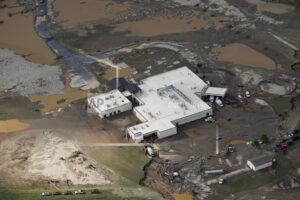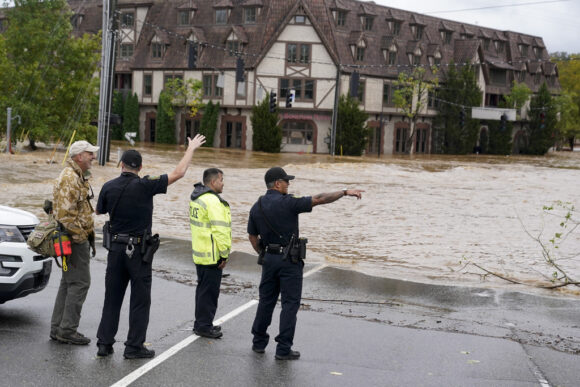Estimates of insured losses from Hurricane Helene continue to range around $5 billion, not including flood insurance losses, as the death toll in the Southeast continued to rise, reaching 107 by Monday morning.
In Florida, the state Office of Insurance Regulation reported almost 40,000 property insurance claims had already been filed by Sunday. Total estimated insured losses have topped $435 million. Those numbers are expected to rise, but thousands of claims may turn out to be mostly damage from flooding, limiting exposure for Florida property insurers.
“This is a manageable event for Florida’s property insurance industry,” former Florida deputy insurance commissioner Lisa Miller told Fox 13 TV news.

A.M. Best estimated that insured losses will be about $5 billion, similar to early estimates released by Gallagher Re, CoreLogic and others.
“Primary insurers underwriting property coverage will likely bear the brunt of those insured losses, given the recent trend by reinsurers to impose higher attachment points on that coverage,” A.M. Best’s Chris Draghi said in a bulletin. “This hurricane could also be a key financial test for Florida property-catastrophe specialist writers, some of which are thinly capitalized.”
The Southeastern U.S. began a huge cleanup and recovery effort on Sunday and the death toll climbed after Helene knocked out power for millions, destroyed roads and bridges and caused dramatic flooding from Florida to Virginia, Reuters new service and others reported.
The storm’s winds, rain and storm surge killed at least 90 people in North Carolina, South Carolina, Georgia, Florida, Tennessee and Virginia, according to a Reuters tally of state and local officials.
Officials feared more bodies would be discovered in the next few days.
Business interruption claims are likely to mount across the region, as floodwaters and road washouts shut down enterprises and cellphone service was non-existent in some areas. The city of Asheville, North Carolina, home of a thriving tourist industry, was heavily flooded and left completely isolated. State officials set up airlifts to bring food and water to residents on Sunday.
“Grocery stores are closed, cellphone service is out,” Chip Frank, 62, said as he entered his third hour waiting in line, according to Reuters. “It all depends on these gas stations. You’re not going to be able to go nowhere, and it’s just a scary feeling.”
The North Carolina Department of Transportation has restricted any travel in the western part of the state.
“This is a devastating catastrophe of historic proportions,” Gov. Roy Cooper told CNN. “People that I talk to in western North Carolina say they have never seen anything like this.”
The extreme water levels caught many off guard. Most losses from flooding in the area will not be covered by insurance.
“Public and private flood policy take-up rates are minimal in the mountainous regions of the Southeast and will predominantly be the responsibility of the property owner,” Guy Carpenter, the global risk and reinsurance firm, said Monday.
Region-wide, total economic losses, aside from insured losses, could reach as high as $110 billion, AccuWeather noted. Moody’s Analytics pegged total losses at no more than $34 billion.
On the west coast of Florida, where heavy storm surge swamped hundreds of homes, mortgage companies may ultimately raise requirements for more flood insurance, Guy Carpenter noted. “Wind insurers may bear expense to adjust water claims with zero ultimate payment.”
A number of fires broke out in Tampa, destroying some homes that also faced damage from storm surge and wind-driven rain.
In storm-plagued Horseshoe Beach, on Florida’s Gulf Coast about 70 miles (120 km) west of Gainesville, Charlene Huggins surveyed the debris of her blown-out house, pulling a jacket out of the rubble on Saturday, Reuters reported.
“Five generations lived in this house, from my grandmother, my father, myself, my daughter, son and my granddaughter,” Huggins said, holding a chipped glass cake stand. “So there’s a lot of memories here. It just breaks your heart.”
Not far away, James Ellenburg stood on the property where his own family has lived for four generations. “I took my first step right here in this yard.”
The roof of one home sat flat in the dirt, its walls blown away.
In coastal Steinhatchee, a storm surge of eight to 10 feet (2.4 to 3 meters) moved mobile homes, the weather service said.
“I’ve never seen so many people homeless as what I have right now,” said Janalea England, of Steinhatchee, a small river town along the state’s rural Big Bend. She turned her commercial fish market into a storm donation site for friends and neighbors, many of whom couldn’t get insurance on their homes, the Associated Press reported.
Other areas saw a storm surge of 15 feet (4.5 meters).
In the nearby tiny community of Spring Warrior Fish Camp, people were surveying the damage on Saturday and still waiting for emergency or first responder aid.
“No one thinks of us back here,” said David Hall, as he and his wife dug through seagrass and dead fish in the office of the hotel they owned. Many of the community’s homes are built on stilts because of a local ordinance and survived heavy damage.
Kristin Macqueen was helping friends clean up after their house was destroyed in nearby Keaton Beach. “It’s complete devastation,” she said. “Houses have just been ripped off their slabs.”
East Tennessee also endured extensive flooding, and a dam was near collapse over the weekend. Water levels behind the Nolichucky Dam near Morristown began to recede, but not until after downstream residents were evacuated.
Top photo: Emergency personnel watch floodwaters rise in Asheville on Friday. (AP Photo/Erik Verduzco)
Topics Profit Loss Flood
Was this article valuable?
Here are more articles you may enjoy.



 Marsh McLennan to Buy TIH’s McGriff Insurance for $7.75B
Marsh McLennan to Buy TIH’s McGriff Insurance for $7.75B  Industry Critiques Trump’s Auto Insurance Rate Data, Promise to Cut Premiums
Industry Critiques Trump’s Auto Insurance Rate Data, Promise to Cut Premiums  State Farm Posts Worst HO Loss Ratio Since 2011; Peers Recover: S&P
State Farm Posts Worst HO Loss Ratio Since 2011; Peers Recover: S&P  AI Being Used to Scam Small Business Owners, Says Nationwide Survey
AI Being Used to Scam Small Business Owners, Says Nationwide Survey 

